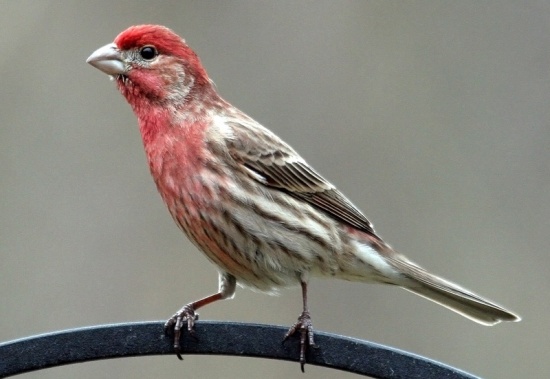- Haemorhous mexicanus
Carpodacus mexicanus
Identification
L. 5-6" (13-15 cm)
Male
- Bright red on crown, breast, and rump (some individuals duller more pink depending on diet)
- A yellow carotinoid variant is sometimes seen (photo below).
Female
- Plain, unstriped head
- Heavy streaking on light underside
Immature males
Less highly coloured, often orangish or yellowish on head and breast
Similar Species
Male Purple Finch and Cassin's Finch lack brown flank streaking and have a shorter more notched tail. Females of both have pale eyebrow and malar lacking in female House Finch.
Variations
In north-west Mexico is a region where House Finch males are extensively red and with much less brownish streaking on the underside[2] (probably subspecies ruberrimus).
Distribution
Western North America, Canada to southern Mexico. Introduced (H. m. frontalis) to eastern North America and (nominate) to Hawaii.
Taxonomy
Formerly placed in genus Carpodacus.
Subspecies
This is a polytypic species consisting of twelve subspecies[1]:
- H. m. frontalis: South-western Canada to western US, Baja California and north-western Mexico
- H. m. clementis: Channel Islands (off southern California) and Los Coronados Islands (off northern Baja)
- H. m. amplus: Guadalupe Island (off Baja California)
- H. m. ruberrimus: Southern Baja California and north-western Mexico (Sonora, southern Sinaloa and south-western Chihuahua)
- H. m. rhodopnus: Arid tropical central Sinaloa
- H. m. coccineus: Mountains of south-western Mexico (southern Nayarit and western Zacatecas to western Michoacán)
- H. m. potosinus: Southern Texas (Rio Grande Valley) to Chihuahua and south-western Tamaulipas
- H. m. centralis: Central Mexican plateau (Guanajuato, Querétaro and adjacent states)
- H. m. mexicanus: South central Mexican plateau (eastern Michoacán to Hidalgo and Oaxaca)
- H. m. roseipectus: Southern Mexico (southern Puebla and Valley of Oaxaca)
- H.. m. griscomi: South-western Mexico (Sierra Madre del Sur of Guerrero)
- H. m. mcgregori: Formerly San Benito and Cedros island (off Baja California). Extinct
Habitat
Deserts, orchards, coastal valleys and forests.
Behaviour
Frequently seen sitting high up on utility wires or other exposed perches.
Breeding
A tightly woven, compact nest is made and set in a bush, thicket, natural cavity, or on a building. The clutch contains 3-5 bluish, lightly streaked or spotted eggs.
Diet
Diet consists mainly of seeds, buds and fruit, with the addition of some insects.
Vocalisation
Male sings throughout the year (except during moult, from late July to October). Song may be given in flight or from perch; an unstructured jumble, higher-pitched than Purple Finch or Cassin's Finch and and concluding with a distinct down-slurred note. Female may give a simpler version of song. Common call is a cheep or cheet, often given in flight. Also a sharp chirp, recalling House Sparrow.
Calls:
Notice that in addition to call of House Finch, there is also sound from Fish Crow at second 10 and again starting at second 19 of the recording.
Recording © by NJLarsen, Carolina Sandhills NWR, South Carolina, USA, 29 April 2023
Movements
Resident, migratory and dispersive. Prior to 1945 those in western part of range occupied breeding areas between late March/early April and September with altitudinal movements to lower levels and plains; sometimes irruptive, wandering throughout range south to Texas and Mexico. Breeders in the northeast part of range move longer distances south & southwest the southern parts of their breeding range. Banding studies show adult females move longer distances on average than males. Most movements diurnal and determined by the availability of food.
References
- Clements, J. F., T. S. Schulenberg, M. J. Iliff, S. M. Billerman, T. A. Fredericks, J. A. Gerbracht, D. Lepage, B. L. Sullivan, and C. L. Wood. 2021. The eBird/Clements checklist of Birds of the World: v2021. Downloaded from https://www.birds.cornell.edu/clementschecklist/download/
- Birdforum thread discussing redder House Finch in Mexico
- Clement, P. (2020). House Finch (Haemorhous mexicanus). In: del Hoyo, J., Elliott, A., Sargatal, J., Christie, D.A. & de Juana, E. (eds.). Handbook of the Birds of the World Alive. Lynx Edicions, Barcelona. (retrieved from https://www.hbw.com/node/61389 on 4 April 2020).
- Badyaev, A. V., V. Belloni, and G. E. Hill (2020). House Finch (Haemorhous mexicanus), version 1.0. In Birds of the World (A. F. Poole, Editor). Cornell Lab of Ornithology, Ithaca, NY, USA. https://doi.org/10.2173/bow.houfin.01
- Clement, P., A. Harris, and J. Davis. (1993) Finches and Sparrows: An Identification Guide. Princeton Univ. Press, Princeton, N. J. ISBN 0-69103-424-9
Recommended Citation
- BirdForum Opus contributors. (2025) House Finch. In: BirdForum, the forum for wild birds and birding. Retrieved 16 May 2025 from https://www.birdforum.net/opus/House_Finch
External Links
GSearch checked for 2020 platform.1










